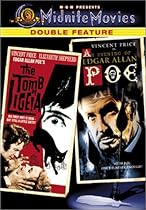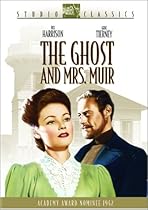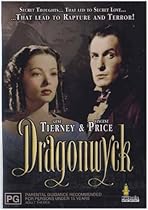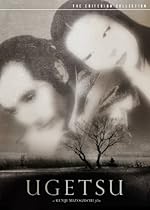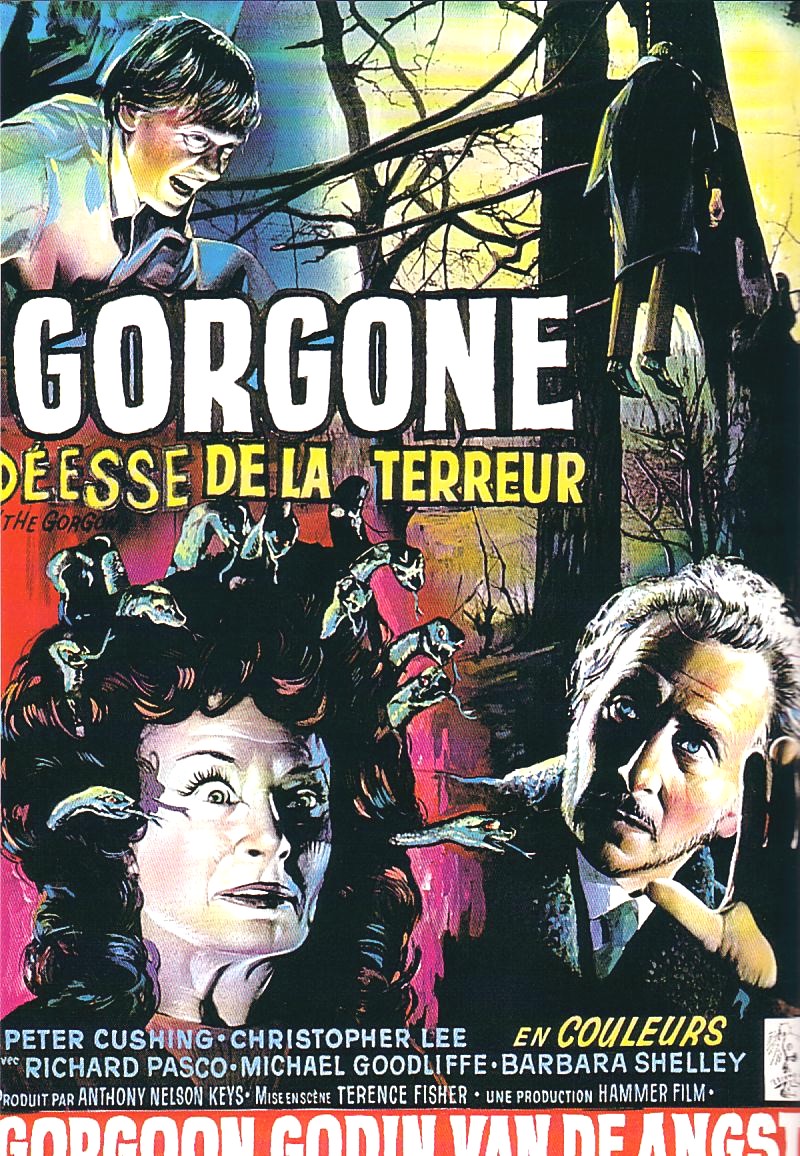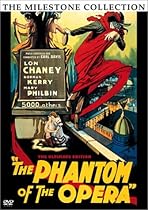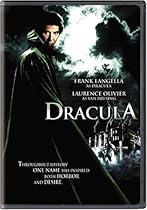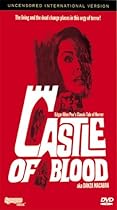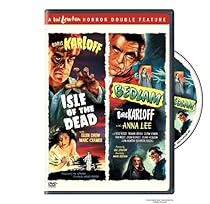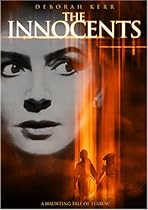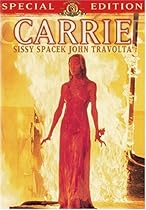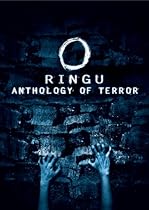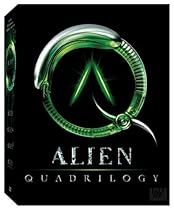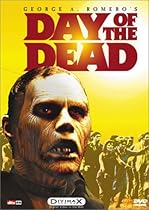
Bram Stoker’s immortal vampire rises again, this time on Blu-ray, a format that – appropriately enough -preserves the youthful veneer of this 1973 production, making it look as good as (if not better than) it did four decades ago. Like Dracula himself, MPI’s new disc will no doubt endure, intact and ageless, for centuries to come, emerging regularly from its box like the Vampire King rising from his coffin at sunset.
DAN CURTIS’ DRACULA (also known as BRAM STOKER’S DRACULA or simply DRACULA) is not the greatest adaptation of the classic novel, but it infuses some new blood into an old corpse drained of life by myriad prior film incarnations. This DRACULA features a strong central performance, atmospheric locations, and some enjoyably scary but not too gruesome moments of horror. However, the film’s greatest claim to historical significance is its (for the time) novel take on the titular character, which went on to influence later interpretations.
THE FILM: BRAM STOKER’S DRACULA
The fourth major adaptation of the classic novel*, BRAM STOKER’S DRACULA (the on-screen title) begins by acknowledging audience familiarity with the tale, opening with shots of wolves (actually German Shepherds) amassing outside Castle Dracula, while the Count walks through a corridor toward the camera, like Norma Desmond ready for her closeup. “We know you know who this is,” the film seems to be saying, “so we’re not going toy with presenting him as a mysterious figure, and we’re not going to tease you with a long wait for what you obviously expect to see.”
After that Richard Matheson’s script settles into the familiar story, but only up to a point. Jonathan Harker (Murray Brown) arrives in Transylvania to arrange a real estate deal with Dracula (Jack Palance). However, the Count has ulterior motives: Harker finds a newspaper photo with a woman’s face circled. The woman is Lucy (Fiona Lewis), whom Dracula believes to be the reincarnation of a woman he loved during his mortal life. She also turns out to be the best friend of Harker’s finace, Mina (Penelope Horner).
After concluding his business with Harker , Dracula leaves the young man to the tender mercies of three vampire women (Virginia Wetherell, Barbar Lindley, Sarah Douglas) and heads to England, where he finds Lucy. Her finance, Arthur Holmwood, consults Van Helsing (Nigel Davenport), who spots the signs of vampirism – though too late to save the victim. After Lucy rises from the grave, Van Helsing and Holmwood stake her in her coffin.
Arriving in her tomb for the expected reunion with his long-lost love, Dracula is enraged to find her undead life snuffed out. He targets Mina next, but the vampire hunters manage to track down the coffins he needs to sleep during the daylight hours; robbed of his refuge, Dracula retreats to Transylvania, with Van Helsing, Holmwood, and Mina in pursuit. The two men stake the Count’s vampire brides in their coffins and confront Dracula himself in a life-or-death battle that ends with Van Helsing tearing down a set of curtains, allowing sunlight to steam inside, incapacitating the monster, who is then dispatched with a spear through the heart.

Back in 1974, when BRAM STOKER’S DRACULA first aired on American television, portraying the Count with a measure of sympathy was innovative and surprising; something so simple as a flashback or two to his days of mortal life was enough to suggest a whole new perspective on the familiar character. Dracula was no longer simply a monster; he had human emotions!
In this, the film was enormously aided by Palance. If you prefer your vampires in traditional Gothic mode, then Palance’s Dracula is for you: the actor registers such powerful screen presence that you feel he could single-handedly dispatch the entire cast of TWILIGHT’s glittering vampire-wimps. Though hardly Continental (the actor avoids affecting a Lugosi-style Hungarian accent), Palance conveys not only the enormous power of the King Vampire (who seems threatening even when he’s not actually doing anything) but also Dracula’s sense of love and loss. He effectively modulates the shifts from fierce to pained to tortured, and you almost feel for him. Almost.
The problem is that BRAM STOKER’S DRACULA does not have the screen time or the focus to completely humanize the Count. The reincarnation plot is clearly derived from Curtis’ own Gothic soap opera DARK SHADOWS (in which vampire Barnabas Collins sought the reincarnation of his lost Josette), but the TV series had the luxury of months of daily episodes to gradually transform Barnabas from predatory villain to doomed anti-hero. Here, we get only a few minutes of flashbacks, which are at odds with the rest of the story.
In attempting to condense Stoker’s lengthy tale while simultaneously introducing new elements, Matheson set himself a near impossible task. It’s great to see several of Stoker’s previously omitted scenes finally transferred to the screen: wolves escort Dracula’s carriage in Transylvania; Dracula uses a lone wolf, liberated from a zoo, to attack Holmwood in a room protected protected from vampires by crucifixes and garlic; Dracula forces Mina to drink blood from an open wound in his chest, tainting her to become a vampire whether or not see dies by his bite. However, some of the novel’s best moments are reduced to almost nothing (Dracula’s vampire brides – a highlight of the novel- barely register), and some of the familiar action fits awkwardly into the new context, which muddles the character’s behavior.

For example, with Jonathan (literally) out of the picture, Mina’s only connection to the vampire hunters is through her friendship with Lucy, so she has no clear reason to stay involved after Lucy’s death. Nevertheless, she remains, living with Holmwood and Van Helsing in Lucy’s house, apparently (though not expressly) with the permission of Lucy’s mother (who is never told what killed her daughter). One wonders why Mina does not return home or (better yet) lift a finger to figure out what happened to Jonathan. The answer is that the script needs to keep her close by, so that she can become Dracula’s second English victim – a development that now seems like an arbitrary remnant of the novel. (In the revised scenario, Dracula is presumably seeking revenge for Lucy’s destruction, but that would have made more sense had the characters been rewritten so that Mina was Holmwood’s fiance – suggesting that Dracula is taking Holmwood’s woman in exchange for Holmwood’s killing Dracula’s great love.)
Consequently, BRAM STOKER’S DRACULA feels like a familiar old puzzle with a few new pieces tossed in – they’re pleasantly surprising, but they don’t quite fit. And speaking of things that do not fit: this film not only tells us that Dracula was once a sensitive, loving human being; it also tells us that the vampire was, in life, Vlad Tsepes, a true-life historical figure known for cruelly impaling his victims on large, painful wooden stakes inserted in the anus – a contradiction the script never attempts to resolve.
Visually, the film belies its made-for-TV origins, with impressive lensing and production values. Dating from an era when most tele-films were point-and-shoot affairs with bland, over-lit photography, this DRACULA looks as good as a theatrical feature from the era. The location shooting enhances the proceedings enormously, lending an authentic European flavor missing from previous versions of the tale (though the interior of Dracula’s abode sometimes looks more like a mansion than a castle).
Dan Curtis knew how to deliver the genre elements a film like this needed, but his strength was more as a producer than a director. At times, he tried too hard to be clever and cinematic, when a more confident director would have let the scene play without the bells and whistles (typical for the era, the zoom lens is used and over-used, like an explanation point dropped by a writer juicing up a line of prose). At other times, Curtis could let a scene fall flat, such as the Mexican Stand-Off during which Van Helsing and Holmwood use crosses to hold Dracula at bay but let him walk out the door for fear of confronting him directly. (You want to yell, “Don’t stand there – do something!”)
When it came to staging action, Curtis could rise to the occasion and deliver effective moments of shock and horror: Dracula’s first encounter with Lucy is emotionally charged – creepy and seductive; the later revelation of her dead body, still beautiful but pale and blue, like a broken doll, is evocative and disturbing. Within the constraints of network television censorship, Curtis spruced up the narrative with bursts of violence that show how overpowering Dracula is compared to mere mortals, emulating but not quite capturing the full-blooded excitement of HORROR OF DRACULA (1958, from which several ideas were clearly borrowed).

Such borrowings occasionally lend an almost off-the-rack quality to the scenes, though viewers without an encyclopedic knowledge of vampire cinema are not likely to notice or care. For example:
- As noted, the vampire romance is borrowed from DARK SHADOWS (there’s even a music box that plays a love them, scored by SHADOWS composer Bob Corbett).
- Dracula tosses someone out a window, as vampire Janos Skorzeny did in THE NIGHT STALKER, a previous Curtis production. (This scene became something of a recurring motif for Curtis – check out BURNT OFFERINGS for another example).
- Jonathan Harker never makes it out of Dracula’s castle, and Dracula is bound by physical limitations, unable to transform into a bat or mist – both element derived from HORROR OF DRACUULA.
- Dracula seeks a woman whose photograph he has seen – an element in NOSFERATU and HORROR OF DRACULA.
- Van Helsing defeats Dracula by tearing down curtains to reveal sunlight. This is taken from HORROR OF DRACULA by way of THE NIGHT STALKER.
The supporting cast fares less well than Palance. Lewis comes off best, emerging as one of Dracula’s most beautiful and alluring victims; unfortunately, she is given little screen time to register the transformation from innocent human to wanton vampire. Ward is an appealing screen presence, but his character has no distinguishing characteristics, nor an emotional journey worth following. Davenport turns Van Helsing into a methodical medical practitioner, without the commanding presence of Edward Van Sloan or the zeal of Peter Cushing. This may be a deliberate choice (an exchange of closeups, before Van Helsing delivers the fatal blow to Dracula, suggests we are supposed to relate to the tragic vampire rather than the heartless hunter), but it leaves the film without a strong protagonist. Horner’s Mina is not the surprisingly smart and capable woman of the book; in fact, she is not much of anything.
Seen in the purifying light of day, BRAM STOKER’S DRACULA is, like much of the producer-director’s work, an unapologetic horror film, eager to embrace genre conventions and deliver familiar elements that appeal to fans. Though no match for DRACULA (1931) with Bela Lugosi, nor HORROR OF DRACULA (1958) with Christopher Lee, the Curtis production is an interesting variation on the tale, bristling with more energy than COUNT DRACULA (1977), the talky public-television version starring Louis Jordan. And for horror historians, the Dan Curtis DRACULA represents an important evolutionary step in the portrayal of the character on screen, retaining the supernatural menace but adding a layer of humanity and romance that would become a bigger part of the character in later versions.
THE BLU-RAY: DAN CURTIS’ DRACULA

MPI’s Blu-ray disc (featuring the title DAN CURTIS’ DRACULA on the box art) presents the film’s theatrical cut in widescreen format, with options for English, Spanish, and French 2.0 soundtracks, along with optional English subtitles for the hard-of-hearing. The theatrical version is slightly gorier than the original broadcast version (all the vampires cough up blood when they die). Also, the tell-tale signs of the film’s television origin (e.g., blackouts for commercial interruptions) are missing, creating a more theatrical viewing experience.
The picture looks great on modern high-def televisions. There is a slight trace of grain (this was shot on film, after all), but the muted colors are lovely (lots of red backgrounds and that peculiar orange that passed for blood in those days). Though the film dates from the era of television screens with a 1.33 aspect ratio, the image looks perfect when cropped to today’s 1.78 aspect ratio (perhaps because the action was framed to work on wider theatre screens).
Bonus features include interviews with Palance and Curtis, Outtakes, Television Cuts, and a British theatrical trailer.
Outtakes offers raw camera footage, minus the on-set set sound, accompanied by music. These are mostly different takes, or slightly longer versions, of footage seen in the film, sometimes withe the crew and slates visible. Though not a blooper reel, there are one or two moments when an actor cracks a smile, as Lewis does after her gasping reaction to being staked.
Television Cuts presents alternate, blood-free takes from the broadcast version. These are limited to a few closeups the death throes of the vampires, who merely gasp when staked, instead of coughing up blood as in the theatrical version.
The Theatrical Trailer is a bit scratched and grainy (which perhaps helps us better appreciate the preserved picture quality of the film itself). EMI, the British distributor, sold the film (under the title BRAM STOKER’S DRACULA) as a bold horror movie, a la Hammer Films Dracula efforts, but also noted the romantic aspect.
The most interesting bonus features are the Interviews. Jack Palance discusses his approach to the character, saying that he did not play Dracula as a villain because that’s not how the character would see himself. Curtis talks about adapting the book, which he says “makes no sense” because Stoker never explains why Dracula leaves Transylvania for England; hence, Curtis decided to “rip-off” the reincarnation story line from DARK SHADOWS, in order to provide the missing motivation. (This explanation was apparently the approved party-line on the subject: Richard Matheson used almost the exact same words when I asked him about his script decades ago.)
[rating=3]
Worth a sanguinary midnight sip.
TRIVIA
BRAM STOKER’S DRACULA was scheduled to make its debut on American television in October 1973; however, the broadcast was preempted by President Richard Nixon’s address regarding the resignation of Vice President, Spiro T. Agnew. The film eventually premiered in Feburary 1974.

Originally billed and advertised simply as DRACULA, the film later came to be known as BRAM STOKER’S DRACULA, to distinguish it from previous versions. The posters and on-screen title cards confused the issue with graphics that conflated the star’s credit with the title and emphasized the character’s name at the expense of the author’s:
JACK PALANCE
as
BRAM STOKER’S
DRACULA
The word “Dracula” is in larger, bolder letters, suggesting that is the true title; Stoker’s name appears to have been included as a way of acknowledging the film’s literary debt to his novel, which is not otherwise credited as the source material for Matheson’s screenplay. The trailer for the subsequent overseas theatrical release adopted the full title, although the British poster, like the on-screen credit, emphasized “DRACULA,” with “Bram Stoker” in smaller type and lower-case letters.
Years later, home video releases also used the BRAM STOKER’S DRACULA moniker. However, since Francis Ford Coppola’s film of the same name, the 1973 production has been sold as “Dan Curtis’ DRACULA” on DVD and Blu-ray (though the on-screen title-credit remains the same).
Perhaps not coincidentally, the Coppola version of BRAM STOKER’S DRACULA (1992) contains two notable similarities to the Dan Curtis production. First, like Matheson before him, James V. Hart’s screenplay identifies the fictional Count Dracula with his historical namesake, Vlad Tsepes, also known as Dracula (i.e., the Son of the Dragon, thanks to his father’s membership in the Order of the Dragon). Second, Dracula (played by Gary Oldman in the Coppola film) is also seeking the reincarnation of his lost love.
The reincarnation plot line, previously used by Curtis in DARK SHADOWS, has no precedent in Stoker’s novel. However, it can be traced to Universal Pictures’ THE MUMMY (1932), which deliberately recycles many elements from the studio’s earlier hit, DRACULA. Curiously, the Dan Curtis DRACULA is a bit vague about whether Lucy really is Dracula’s lover reborn. She looks the same but never expresses any recognition, even when she is falling under the vampire’s spell; also, when she rises as a vampire, she heads not to the Count but to her fiance, suggesting she does not reciprocate Dracula’s centuries-old passion.
FOOTNOTE:
- After NOSFERATU (1922), DRACULA (1931), and HORROR OF DRACULA (1958).
DAN CURTIS’ DRACULA (Blu-ray title, released May 27, 2014 by MPI). Also known as: DRACULA and BRAM STOKER’S DRACULA (copyright date, 1973; original air date: February 8, 1974). 100 mins. Made for Television. Produced and directed by Dan Curtis. Written by Richard Matheson, based on the novel by Bram Stoker (uncredited). Cast: Jack Palance, Simon Ward, Nigel Davenport, Pamela Brown, Fiona Lewis, Penelope Horner, Murray Brown. Virginia Wetherell, Barbara Lindley, Sarah Douglas.









